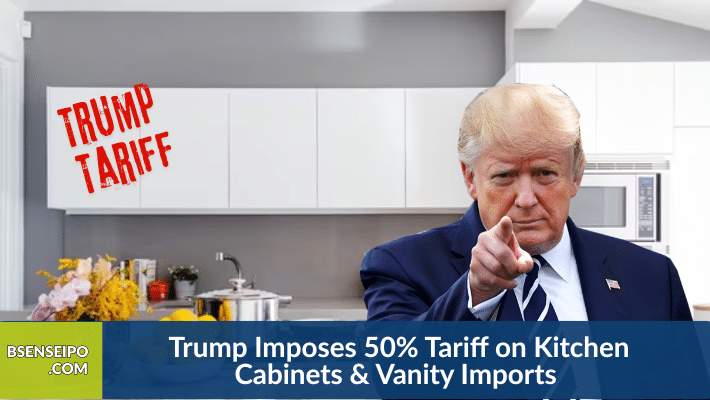Kitchen Product Stocks Brace as Trump Imposes 50% Tariff on Cabinets & Vanities
Starting October 1, Trump imposes 50% tariff on imported kitchen cabinets, vanities, and related components, pushing up costs, reordering supply chains, and putting pressure on stocks tied to home improvement and furnishing. Analysis of impact and stock implications inside.
Washington, D.C. — September 25, 2025 — As part of a new wave of protectionist trade measures, President Donald Trump announced that effective October 1, Trump imposes 50% tariff on imports of kitchen cabinets, bathroom vanities, and associated kitchen components/parts, citing “national security and other reasons.”
This tariff is part of a broader package that also includes a 100 % tariff on branded pharmaceutical imports and other duties on heavy trucks and furniture.
Trump’s announcement (via social media) suggests that the tariff is aimed at preventing “flooding” of low-cost imports from overseas, especially those produced in Asia or low-wage countries, and to incentivize domestic manufacturing.
Why This Tariff Matters
- Kitchen cabinets & bathroom vanities are a significant segment within home furnishing/home improvement imports. A 50 % increase in duty is a large cost shock.
- Many components of kitchen systems (hardware, fittings, structural panels) are globally sourced; so the tariff affects not just finished cabinets but also modules imported as parts.
- Homebuilders, remodelers, and furniture firms relying on imported components will face input cost inflation, which may be passed on to consumers.
Impact on Kitchen Products & Supply Chains
- Cost Pressure & Price Hikes
With import duty doubling effective landed cost (from whatever baseline to +50 %), prices of cabinets, vanities, modular kitchen setups will jump, squeezing margins unless companies absorb costs or pass them on. - Supply Chain Reorientations
Importers may seek alternate sources from countries with trade agreements or build U.S. manufacturing capacity to circumvent tariffs. Some supply chains may regionalize or shift to near-shoring. - Component Disaggregation Issues
If cabinets are assembled from imported parts (e.g. panels, hinges, drawer slides), tariffs on finished goods might extend (or be circumvented by) component import taxes or reclassification disputes. The scope of “associated products” will matter. - Delayed Projects & Consumer Responses
Home renovation or new construction projects may slow if kitchen costs spike. Consumers may defer upgrades or opt for locally manufactured alternatives. - Domestic Manufacturers Benefit
Domestic cabinet makers/component fabricators in the U.S. could see increased demand and competitive advantage, particularly those already operating with full “Made in U.S.” supply chains. - Regulatory / Legal Challenges
The tariff’s legality, especially under trade law or presidential authority, could be challenged. Definitions, exemptions, and enforcement rules will be critical. For example, which kitchen components are covered? Does “associated” include hardware, plywood, MDF panels, etc.?
Impact on Company Stocks & Sector Players
The tariff’s ripple effects will touch multiple categories of players in the home goods, cabinetry, building materials, and furnishing sectors. Below is a breakdown of likely stock/segment impacts:
| Segment/Player Type | Likely Reaction | Examples/Notes |
|---|---|---|
| Large U.S. Home Furnishing/Cabinet Companies | Mixed — those with U.S. manufacturing are insulated; those importing parts or cabinets face margin compression | Companies like Master Brand Cabinets (part of Fortune Brands), IKEA (if U.S. operations import parts), KitchenAid / Whirlpool’s cabinetry components |
| Component Suppliers/Hardware Makers (global importers) | Negative — imported hinges, slides, hardware, and fittings may face downstream tariff burden | Hardware firms that export parts to the U.S. may lose margin or see orders drop |
| Wood Panel/Plywood/MDF Importers | Adverse — if panels used in cabinets are imported, they may see reduced volume or renegotiated contracts. | Firms in Asia or Latin America exporting to the U.S. market |
| Domestic U.S. Cabinet/Millwork Manufacturers | Positive — may gain market share as imports become more expensive | Smaller regional cabinet makers or firms making “Made in U.S.” kitchens |
| Homebuilders & Renovators | Negative hit on project costs; may cut volume or lower margins | Large homebuilders (e.g., Lennar, D.R. Horton, Toll Brothers) might see increased costs in their finishes budgets |
| Retail/Big Box Home Goods Chains | Mixed — inventory purchased already may buffer short-term; future sourcing disrupted | Retailers like Home Depot, Lowe’s could face margin pressure or stock distortion across items |
Stock Market Reaction Outlook
- Stocks importing cabinet components might see downward pressure as margins are expected to tighten.
- Domestic manufacturers or U.S.-based cabinet producers could be viewed favorably by investors seeking beneficiaries of trade protection.
- Broader home improvement and furnishing stocks might experience volatility as investors reassess cost structures, supply chain exposures, and consumer demand elasticity.
Already markets have responded negatively: global indices and Asia markets fell following the tariff announcements. Stocks tied to home goods are likely to come under stress in U.S. equities.
Risks & Uncertainties
- Scope ambiguity: What exactly counts as “kitchen cabinets, vanities, associated products” may be disputed.
- Exemptions & grandfathering: Products already in U.S. warehouses or under contract may be exempt temporarily.
- Legal challenges: The tariff may be contested as beyond executive authority or violating trade treaties.
- Retaliation & trade conflicts: Countries affected may impose countermeasures, complicating trade in building materials.
- Consumer pushback: Home cost inflation is politically sensitive; pressure may force reversals or carveouts.
What To Watch
- Clarifications from U.S. Customs & Border Protection on the tariff’s classification codes (HTSUS) for kitchen products.
- Exemption rules (if any) for companies building U.S. factories or “in process” inventory.
- Stock earnings updates from key home goods/cabinetry firms in October & Q4.
- Price increases passed downstream from distributors to contractors and end consumers.
- Legal rulings over the tariff’s constitutionality or trade authority.




